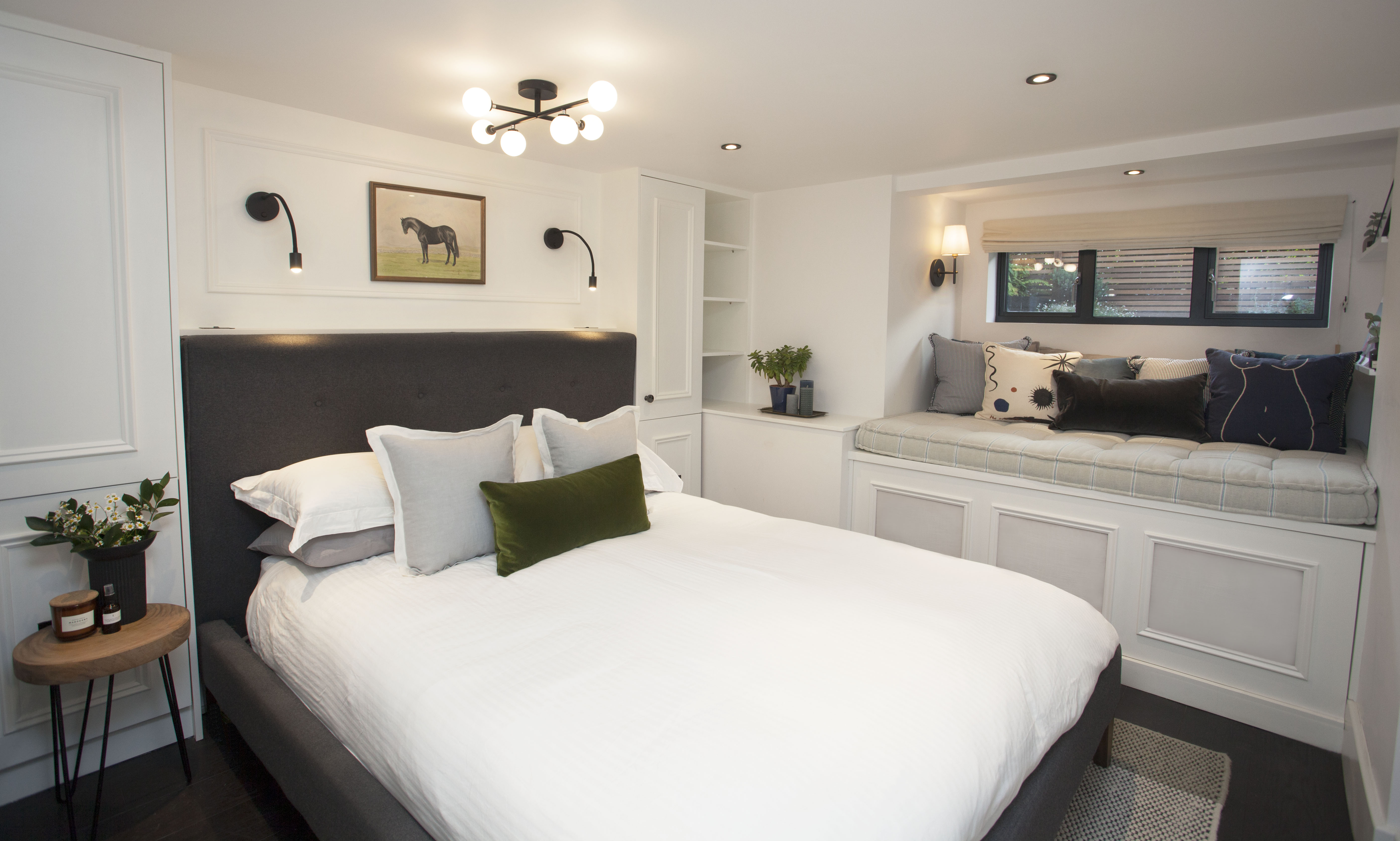Basement remodeling costs: How much it costs to remodel a basement, plus how to budget and money-saving tips
Builders share professional guidance for planning your basement remodeling costs.


Your basement is full of untapped potential. (Well, it may be full of stuff, too, but we’ll get to that.) Whether your growing family is bursting at the seams, or you need space for a new home office, all that space down below is begging to be used. But before you start packing boxes, you'll need to know what your basement remodel will cost. Let’s lay a solid plan of action and create a budget that works for you.
- See also: How to convert a basement into an apartment
How much does a basement remodel cost?
Basement remodeling costs span a wide range of price points. The good news it: It can usually be done on a budget.
According to HomeAdvisor, which aggregates data from the homeowners and contractors that use its platform, the average basement remodel or renovation costs $11,018 - $29,702.
Of course, the costs can increase dramatically, say, if you plan to add features like a full bar or bathroom in your downstairs space. Remodeling magazine’s Cost vs. Value Report 2017 says a midrange basement remodel that includes drywall, paint, flooring, a wet bar, main room, and full bath costs, on average, $71,115, but also brings a brings a 70 percent ROI. Of course, your exact ROI will depend on where you live.
The online real estate marketplace Zillow, says that homeowners in the Pacific region see the greatest ROI of 86.4 percent and those in New England see the lowest, at 52.8 percent. Other factors that affect your ROI include the materials used in the construction and the potential use of the space.
The cost of your basement remodel will also vary greatly depending on materials you use, your contractor, the scope of work, and more.
- See also: The best storage ideas for basements
What impacts basement remodel costs?
Besides location, the cost of your basement remodel hinges on several components. Once cleaned out, if you discover mold and mildew, rotted wood, or other moisture damage, repairing those items will add to the cost. According to the online home marketplace HomeAdvisor, repairing faulty basement drainage that led to damage could add $2000 to the bottom line. Disposing of building materials is an expense, as well as obtaining all of the required permits. But when breaking down the cost of the actual project, your expenses will fall into the following categories.
Get small space home decor ideas, celeb inspiration, DIY tips and more, straight to your inbox!
Waterproofing
No matter what you plan to do with the space, you want it dry and comfortable. HomeAdvisor lists waterproofing as the single most expensive task in a basement remodel, with an average cost of $4,500 nationwide. “All basements will take in water,” says Alan Archuleta, president of Archuleta Builders in Morristown, New Jersey. “It’s what we do with that water that matters.” He says that 80-90 percent of moisture problems start on the exterior by misdirected gutters, mulch that holds water up against the foundation, or the landscape having the wrong pitch. “You don’t fix the inside until you fix the outside,” he says.
Part of the waterproofing process includes installing a sump pump if you don’t already have one, and a back-up in case the first one fails. A back-up may not have been important for the unfinished basement, but if someone is living down there, it’s critical.
Design
Do you want to turn your basement into one big game room for the pool table and large screen TV? Or, do you want an in-law suite with a kitchen and bath? The elements included in your basement will determine the overall cost. “Kitchens and bathrooms are always the most costly renovations,” says Jimmy Dollman, principal of Dollman Construction in Roanoke, Virginia, “whether they’re on the main floor or in the basement.”
Dollman always advises clients to include a universal design to accommodate for disabilities. “You might not need it now,” he says, “but you never know when something might happen that you need a bedroom and bathroom all on one level.”
The biggest mistake Dollman sees in basement planning is not installing a separate HVAC system. “If mom’s going to live there, she’s going to want it warmer and will need her own thermostat,” he says. “If you’re going to use the space for recreation, and have eight to 10 people down there, you may want it cooler than the upstairs. Don’t base your decision on how you feel on your previous occasional jaunts down the stairs.”
Labor
HomeAdvisor says the cost of labor for a basement remodel is about 10 to 25 percent of the job. Archuleta says that’s a light assessment. “Basements are more labor-intensive than main floor projects,” he says. “Most basements don’t have easy access and getting bulk materials inside increases labor cost over the rest of the home.” In other words, give your budget a little extra padding when it comes to labor.
Materials
After the cost of waterproofing, the materials necessary to finish the rest of the job make up the bulk of the expense, including plumbing and electrical parts. Of course, material quality and cost vary widely. Ceramic tile will cost more than laminate flooring, while recessed can lights will be more expensive that a single overhead light fixture.
How to start planning a basement remodel
Researching on the internet is a great place to start your basement remodel cost research. But, you'll really start to get an idea of what you should budget when you begin to actually plan your remodel. That is: talking to contractors and designers, looking at materials, and consulting with local building officials on permits. Here's how to start the process.
Step One
Check with your local building official. The building official will tell you what you can and can’t do in your basement based on local residential building and zoning regulations. If you live in a rural location, also check with the health department to see if your septic system will support what you want to include.
Step Two
If you’re going to include more than just one big open space (say, if you're adding a basement bathroom or a kitchenette), you’ll want to consult with a professional designer. You may be tempted to give a vague description to the contractor and let him “have a go,” but that plan of action could be disastrous. Some contractors offer design/build services. Others don’t. Having a certified designer on your team will save you money in the long run.
According to Gabby Koontz, a certified kitchen designer and certified aging-in-place specialist from Harrisonburg, Virginia, working with an expert helps you avoid pitfalls that could cost you money. A designer understands the building process, knows how to take proper measurements, stays up-to-date on product design, and can be your guide throughout the process.
Step Three
Now that you know what you’re allowed to do, and you’ve found a designer and/or contractor to make it happen, it’s time to set a budget. Actually, the design/budget phase is a back and forth process between your wants and needs. It helps to make a need list and a wish list. Then, work with your designer and/or contractor to finalize a design you love that fits within the budget.
How to save money on a basement remodel
Looking for ways to remodel your basement on a budget? There are some things you can do to save money in the process.
Do it yourself—While we don't recommend tackling an entire basement remodel on your own unless you're a very experienced DIYer, you can contribute to smaller projects throughout the renovation process. If you’re handy with a hammer or paintbrush, ask your contractor if you can do some of the work yourself to save labor cost. Homeowners can save money by doing straightforward, safe jobs like painting or laying tile.
Choose different materials—Since the cost of materials varies, shop around and start with the basics. If you want to save on the budget, consider carpet over tile floors, stock cabinetry over custom, or solid surface countertops over granite. However, Dollman cautions homeowners to make sure all materials are rated for below-grade use, particularly the flooring.
Complete the work in stages—If you want a complete in-law suite in your basement but don’t have enough funds, find a contractor who’ll do the project in phases. Phase 1 could be the tear out, waterproofing, and code requirements like points of egress. Phase 2, the wiring, plumbing, and adding interior walls. And so on.
Choosing a contractor
Hiring the right team is one of the most important things you can do to keep your budget under control. Not only will labor costs vary, but you'll also want to choose a legitimate professional who won't end up costing you more money in the long-run when you have to re-do shoddy work.
The National Association of the Remodeling Industry (NARI) says the best way to find a qualified professional is word of mouth. If your friends and colleagues haven’t had similar work done, though, check reputable sites like NARI’s member list, Angie’s List, or our Find a Builder Guide.
NARI also recommends you choose someone local, who is licensed and insured (ask to see their credentials) and has no outstanding or unresolved complaints. Check with the Better Business Bureau.
Once you have a few suggestions, look the contractors up online and read their reviews or testimonials to help you narrow it down. Then make the call to schedule an interview.
Carol J. Alexander writes website copy, blog posts, and feature articles on home remodeling and construction topics from her home in the Shenandoah Valley of Virginia. In addition to Real Homes, notable clients include, This Old House, Family Handyman, and Florida Roofing magazine.
